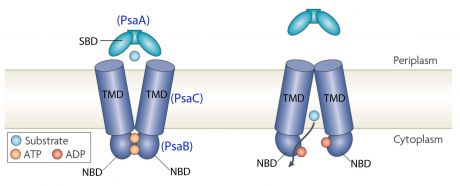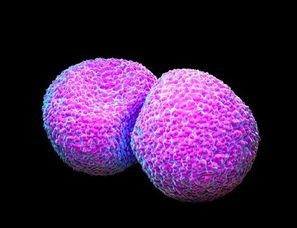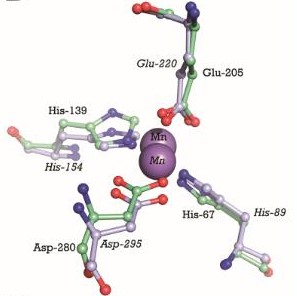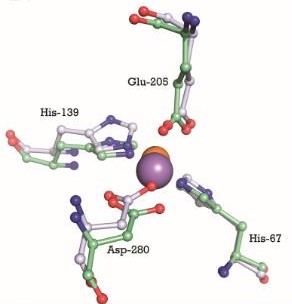Elizeu/sandbox/citocromo c
From Proteopedia
| Line 27: | Line 27: | ||
== Structure == | == Structure == | ||
| - | As a member of the Lipoprotein receptor-associated antigen I (LraI) family, the PsaA molecule contains four distinct regions. An N-terminal leader sequence of 20 amino acids holds an LxACy consensus sequence that is recognized and cleaved by signal peptidase II. A lipid moiety is | + | As a member of the Lipoprotein receptor-associated antigen I (LraI) family, the PsaA molecule contains four distinct regions. An N-terminal leader sequence of 20 amino acids holds an LxACy consensus sequence that is recognized and cleaved by signal peptidase II <ref>PMID:28011228</ref>. A lipid moiety (diacylglycerol <ref>PMID:PMC99024</ref>) is added to the cysteine residue and mediates the anchorage of the protein to the cytoplasmic membrane. Apart from this leader sequence, the rest of the protein consists of two twofold-pseudosymmetrical (β/α)4 sandwich domains, of which the β-strands of each domain form parallel β-sheets <ref>PMID:PMC99024</ref>. In total the two domains form two lobes connected via an α-helical linker which constitutes the solute-binding site <ref>PMID:28011228</ref>. |
<Structure load='3ZK7' size='400' frame='true' align='test' caption='3D structure of PsaA in the metal-free, open state'/> | <Structure load='3ZK7' size='400' frame='true' align='test' caption='3D structure of PsaA in the metal-free, open state'/> | ||
<Structure load='3ZTT' size='400' frame='true' align='text' caption='3D structure of PsaA with manganese ion'/> | <Structure load='3ZTT' size='400' frame='true' align='text' caption='3D structure of PsaA with manganese ion'/> | ||
Revision as of 15:31, 26 January 2017
User: Julie Langlois/PsaA NCBI Accession: P42363.1 Uniprot Accesion: POA4G2 PDB ID: 3ZK7 Molecular weight: 34,538 kDa [1] /datasheet.php?products_id=1261287
Contents |
Overview
PsaA protein
PsaA (Pneumococcal surface antigen A) is a multi-functional lipoprotein detected on all known serotypes of Streptococcus pneumoniae. This lipoprotein belongs to the ABC-type transport protein complex that transports Mn2+. The overall size of the protein approximated from its crystal structure is 40 by 40 by 70 Å. ABC means ATP binding complex. PsaA is also an adhesion factor that plays a major role in pneumococcal attachment to the host cell and virulence. PsaA is hidden beneath the cell wall. PsaA protein is involved in in colonization of the nasopharyngeal mucosal.
This transporter is composed of the products of three genes, psaB (ATP-binding protein), psaC (integral membrane protein), and psaA (solute-binding lipoprotein), which are organized in an operon with a gene encoding PsaD, a thiol peroxidase [2].

Image:Linear structure PsaA.jpg Linear structure of PsaA
Between the first to the 24th amino acid namely the red motif there is the signal peptide and the second one is the Pfam motif[3].
Zinc in excess has significant toxicity to bacteria because it is an important innate defence mechanism. There are many Zinc in human body. Manganese is important for the virulence, growth and proliferation of Streptococcus pneumoniae. Zinc could compete for Manganese binding. However Manganese has more affinity for PsaA than Zinc but Zinc is not transported by the ABC-transporter. Zinc competition reduces intracellular Manganse resulting in up-regulation of PsaBCA expression.
Streptococcus pneumoniae
Streptococcus pneumoniae is a Gram positive cocci (with a diameter from 0.5 to 1 μm) and a member of the genus Streptococcus. It can live under aerobic or anaerobic conditions. It resides in the nasopharynx of healthy carriers. However the bacterium may become pathogenic in elderly and immunocompromised people and children. Then it can spread to other locations and cause disease. Its genome of S. pneumoniae is a closed, circular DNA structure that contains between 2.0 and 2.1 million base pairs.[4]
Structure
As a member of the Lipoprotein receptor-associated antigen I (LraI) family, the PsaA molecule contains four distinct regions. An N-terminal leader sequence of 20 amino acids holds an LxACy consensus sequence that is recognized and cleaved by signal peptidase II [5]. A lipid moiety (diacylglycerol [6]) is added to the cysteine residue and mediates the anchorage of the protein to the cytoplasmic membrane. Apart from this leader sequence, the rest of the protein consists of two twofold-pseudosymmetrical (β/α)4 sandwich domains, of which the β-strands of each domain form parallel β-sheets [7]. In total the two domains form two lobes connected via an α-helical linker which constitutes the solute-binding site [8].
|
|
This image shows the metal binding site in more detail, with the MntC residues and Manganese. Manganse ions are shown as purple spheres. We can see that Manganese interacts with Histine residues, Aspartique acid residues and Glutamique acid residues.
This image shows the metal binding site in more detail, with MntC residues and Managanese and Zinc. Manganese ion is shown as a purple sphere and Zinc ion is shown as an orange sphere.
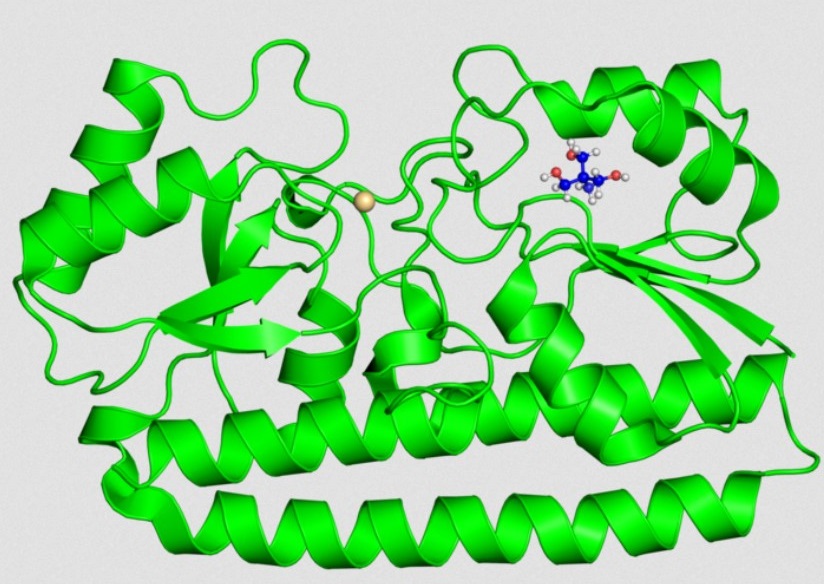 3D structure of PsaA with 2-AMINO-2-HYDROXYMETHYL-PROPANE-1,3-DIOL (tris) and cadmium[9]
3D structure of PsaA with 2-AMINO-2-HYDROXYMETHYL-PROPANE-1,3-DIOL (tris) and cadmium[9]
Cadmium uptake reduces the millimolar cellular accumulation of manganese and zinc, and thereby increases sensitivity to oxidative stress [10].
This is a test to add a in the Sandbox
Protein-protein interaction
Function
Disease
Meningitis
Otitis
PsaA has been recognized to be involved in the adherence and virulence mechanisms of otitis media. Streptococcus pneumoniae is one of the main agents causing bacterial acute otitis media, directly or as complication of a viral upper respiratory tract infection. This disease is a highly prevalent pediatric disease worldwide. Hearing loss is a common problem associated with this disease. [11] Progress in vaccine development is most advanced for Streptococcus pneumoniae. Indeed, there is a seven-valent capsular-conjugate vaccine, PREVNAR® but it is rather non efficient for otitis media.[12]
Pneumonia
PsaA protein is an adhesin which is involved in colonization of the nasopharyngeal mucosal. Moreover, alveolar pneumonia is caused by the spread of Streptococcus pneumoniae from nasopharynx. Therefore PsaA protein is involved in infection of pulmonary parenchyma by Streptococcus pneumoniae. Sometimes, Streptococcus pneumoniae pass into the blood and causes a bacteremia besides pneumonia.
Application in Biotechnology
PsaA is being actively evaluated as a component of a vaccin in formulations composed of pneumococcal common proteins. PsaA has been expressed as an E.coli recombinant protein, purified, and evaluated in a phase one clinical trial.
References
- ↑ https://www.mybiosource.com/prods/Recombinant-Protein/Manganese-ABC-transporter-substrate-binding-lipoprotein-psaA/psaA
- ↑ Moore RC. Investigational drug information is available to the pharmacist. Am J Hosp Pharm. 1979 Nov;36(11):1480, 1484. PMID:517531
- ↑ http://string-db.org/cgi/network.pl?taskId=EA2jsQm5Sc5A
- ↑ Bierman EL, Stein O, Stein Y. Lipoprotein uptake and metabolism by rat aortic smooth muscle cells in tissue culture. Circ Res. 1974 Jul;35(1):136-50. PMID:4366526
- ↑ Yu Y, Chang, Xu H, Zhang X, Pan L, Xu C, Huang B, Zhou H, Li J, Guo J, Liu C. The virulence of Streptococcus pneumoniae partially depends on dprA. Braz J Microbiol. 2016 Dec 6. pii: S1517-8382(16)30151-4. doi:, 10.1016/j.bjm.2016.10.019. PMID:28011228 doi:http://dx.doi.org/10.1016/j.bjm.2016.10.019
- ↑ PMID:PMC99024
- ↑ PMID:PMC99024
- ↑ Yu Y, Chang, Xu H, Zhang X, Pan L, Xu C, Huang B, Zhou H, Li J, Guo J, Liu C. The virulence of Streptococcus pneumoniae partially depends on dprA. Braz J Microbiol. 2016 Dec 6. pii: S1517-8382(16)30151-4. doi:, 10.1016/j.bjm.2016.10.019. PMID:28011228 doi:http://dx.doi.org/10.1016/j.bjm.2016.10.019
- ↑ http://www.ebi.ac.uk/pdbe/entry/pdb/4UTO
- ↑ http://www.nature.com/articles/ncomms7418
- ↑ https://www.google.com/patents/US20130078254
- ↑ Wald ER, Mason EO Jr, Bradley JS, Barson WJ, Kaplan SL. Acute otitis media caused by Streptococcus pneumoniae in children's hospitals between 1994 and 1997. Pediatr Infect Dis J. 2001 Jan;20(1):34-9. PMID:11176564
Proteopedia Page Contributors and Editors (what is this?)
Julie Langlois, Atena Farhangian, Rebecca Holstein, Elizabeth A. Dunlap, Katherine Reynolds, Elizeu Santos, Noam Gonen, Anna Lohning, Idan Ben-Nachum, Brian Ochoa, Shai Biran, Gauri Misra, Shira Weingarten-Gabbay, Keni Vidilaseris, Jamie Costa, Abhinav Mittal, Urs Leisinger, Madison Walberry, Edmond R Atalla, Brett M. Thumm, Brooke Fenn, Joel L. Sussman, Mati Cohen, Vesta Nwankwo, Dotan Shaniv, Gulalai Shah
